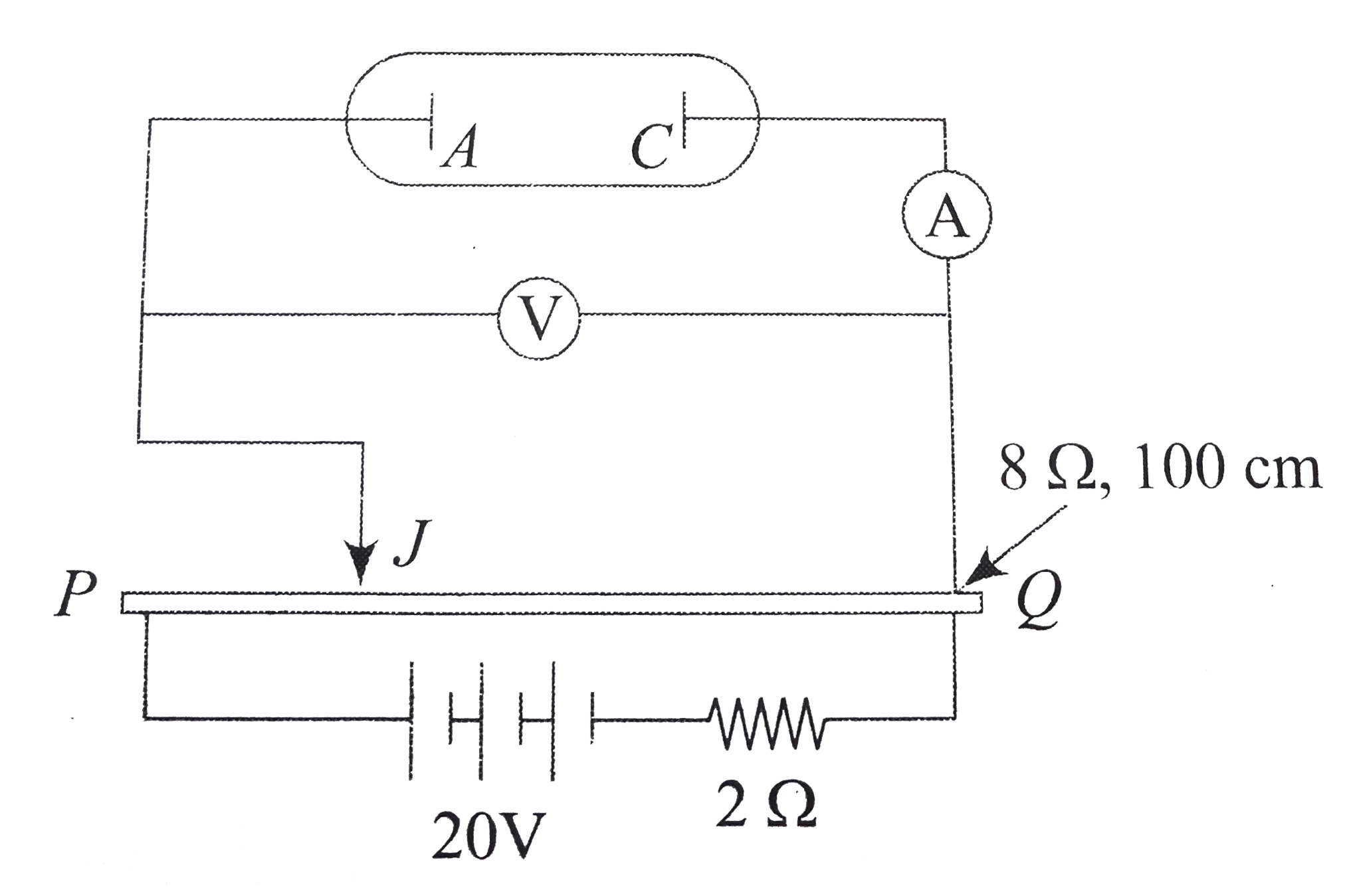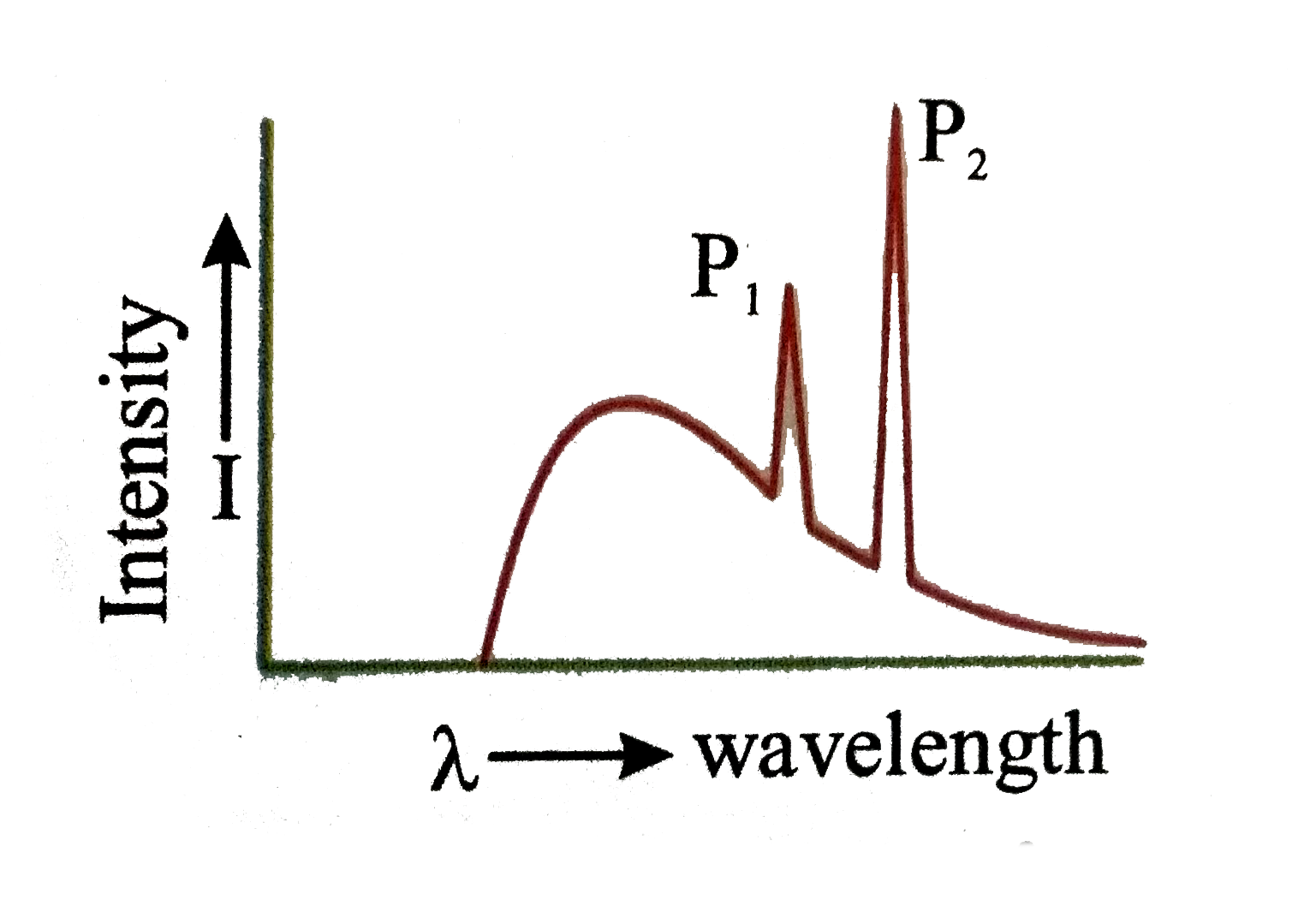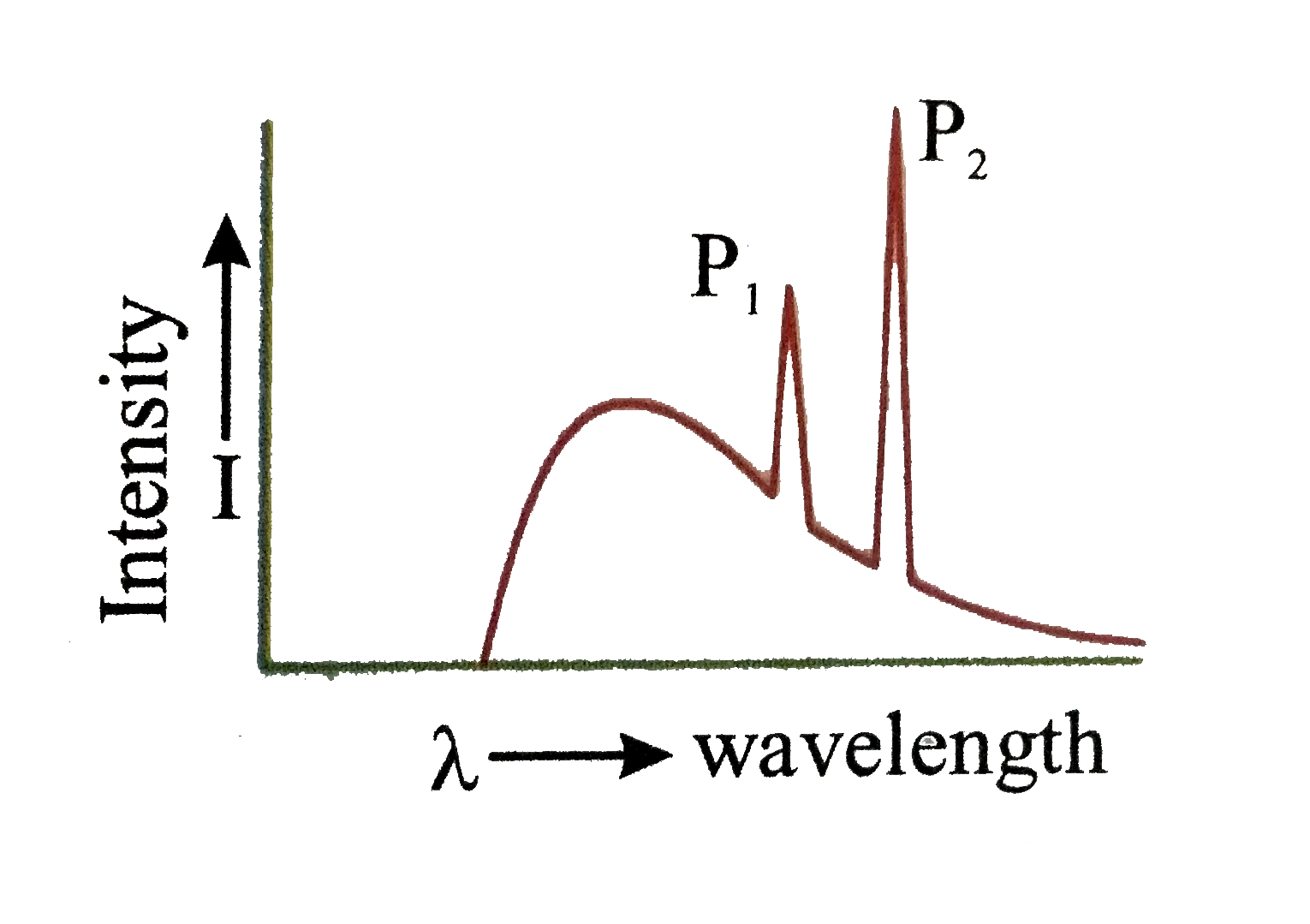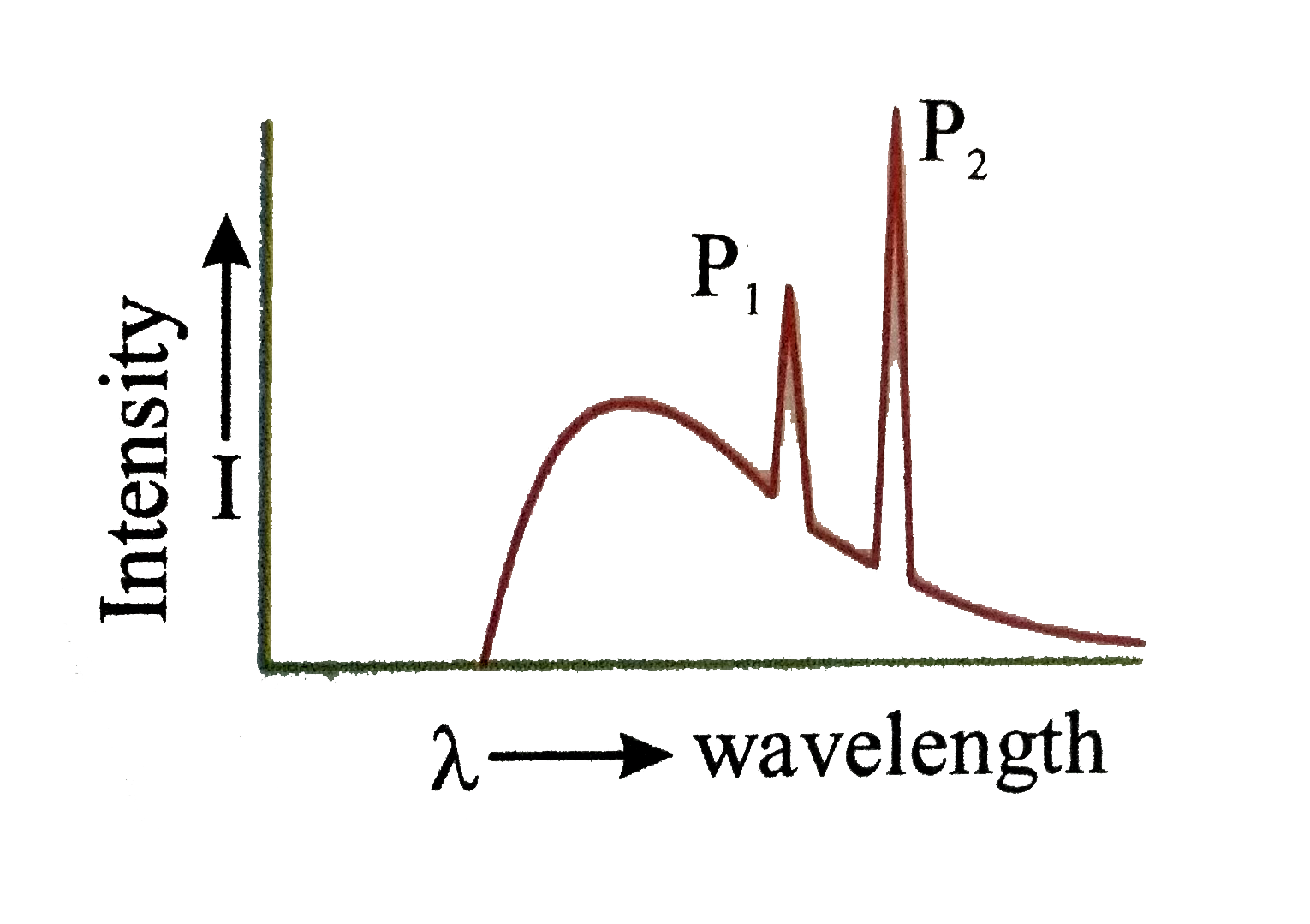A photoelectric current emerging in the circuit of a vacuum photocell when its zinc electrode is subjected to electromagnetic radiation of wavelength 262nm is cancelled if an external decelerating voltage 1.5V is applied. Find the magnitude and polarity of the outer contact potential difference of the given phtocell.
The maximum K.E. of the photoelectrons emitted by the Zn cathode is
E_(max) = (2picancelh c)/(lambda)-A_(zn)
On calculating this comes out to be 0.993eV=1.0eV
Since an external decelerating voltage of 1.5V is required to cancel this current, we infer that a contact potential difference of 1.5−1.0=0.5eV exsists in the circuit whose polarity is oppsoite the decelearating voltage.
Topper's Solved these Questions
- OPTICSBook:IE IRODOV, LA SENA & SS KROTOVChapter:OPTICSExercise:Exercise
Explore 2 Videos
- OPTICSBook:IE IRODOV, LA SENA & SS KROTOVChapter:OPTICSExercise:Optics Of Moving Sources
Explore 22 Videos
- MECHANICSBook:IE IRODOV, LA SENA & SS KROTOVChapter:MECHANICSExercise:Mechanics Problems
Explore 92 Videos
- OSCILLATIONS AND WAVESBook:IE IRODOV, LA SENA & SS KROTOVChapter:OSCILLATIONS AND WAVESExercise:Electromagnetic Waves, Radiation
Explore 36 Videos
Similar Questions
There is a vacuum photocell whose one electrode is made of cesium and the other of copper. Find the maximum velocity of photoelectrons approaching the copper electrode when the cesium electrode is subjected to electromagnetic radiation of wavelength 0.22μm and the electrodes are shorted outside the cell.
View Solution(a) Photoelectric threshold of metallic silver is λ=3800Å. Ultravilolet light of λ=260 nm is incident on silver surface. Calculate :
(i) the value of work function in joule and eV
Kmax of the emitted photoelectrons
(iii) vmax of the photoelectrons
(b) Ultraviolet light of wavelength 280 nm is used in an experiment on photoelectric effict with lithium (ϕ=2.5eV) cathode. Find
(i) the maximum kinetic energy of the photoelectrons
(ii) the stopping potential
(c) Find the maximum magnitude of the linear momentum of a photelectron emitted when light of wavelength 400 nm falls on a metal (ϕ=2.5eV).
(d) A monochromitc light source of intensity 5 mW emits 8×105 photons per second. This light ejects photoelectrons from a metal surface. The stopping potential for this set up is 2.0V . Calculate the work function of the metal.
(e) The maximum kinetic energy of photoelectrons emitted from a certain metallic surface is 30 eV when imonochromatic radiation of wavelength λ falls on it. When the same surface is illuminated with light of wavelength 2λ the maximum kinetic energy of photo electrons is observed to be 10 eV. Calculate the wavelength λ and determine the maximum wavelength of incident radiation for which photoelectrons can be emitted by this surface.
View Solution
Knowledge Check
Radiation of wavelength 546 nm falls on a photo cathode and electrons with maximum kinetic energy of 0.18 eV are emitted. When radiation of wavelength 185 nm falls on the same surface, a (negative) stopping potential of 4.6 V has to be applied to the collector cathode to reduce the photoelectric current to zero. Then, the ratio he is
A6.6×10−15JsC−1B4.14×10−15JsC−1C6.6×10−34JsC−1D4.12×10−34JsC−1
An experimental setup of verification of photoelectric effect is shown if Fig. The voltage across the electrodes is measured with the help of an ideal voltmeter, and which can be varied by moving jockey J on the potentiometer with wire. The battery used in potentiometer circuit is of 20 V and its internal resistance is 2Ω. The resistance of 100 cm long potentiometer wire is 8Ω.
The photocurrent is measured with the help of an ideal ammeter. Two plates of potassium oxide of area 50cm2 at separation 0.5mm are used in the vacuum tube. Photocurrent in the circuit is very small, so we can treat the potentiometer circuit as an independent circuit. The wavelength of various colors is as follows:
Q. Calculate the number of electrons that appear on the surface of the cathode plate, when the jockey is connected at the end P of the potentiometer wire. Assume that no radiation is falling on the plates.A8.85×106B11.0625×109C8.85×109D0The properties of x -rays as put forwarded by Rontgen in his pioneering paper on the topic are as follos:
X-rays posses a very strong pentrative power it can penetrate wood upto 3cm and and aluminium foil upto 15mm . If the hand if the hand is held between the discharge tube and the screen the dark shadow of the of the bones os visible within the slightly dark shadow of the hand"
photographc plates and film "show themselves susceptible to x- rays " Hence , photography provided a valuable method of studying the effect of x-rays
xrays neither reflected nor reflected refracted (so far as Rontgen could discover ). Hence , " X - rays as cannot be concerted by lenses"
X- rays discharge electrified bodies , whether the electrification is positive or negative .
X-rays are generated when the cathode rays of the discharge tube strike any solid body .A heavier element , such as plantium , however is much more efficient as a generator of X - rays than a lighter element , such as aluminium . Most of Rontgen 's observation stood the test of time, though some of them needed to be modified later. V, then maximum energy of emitted photon could be Emax=eV,hcλmin=hceV
λmin is also called cut off wavelength . since electron may loose very small energy in a given collision, the upper value of lambd eill approach infinity . when X-rays is produced in X-ray tube , two types of X-rays spectra and line are observed: continous spectra and line spectra. A continous spectra is produced by bremsstrahlung, the electromagnetic radiation produced when free electron are accelerated during collision with ions.
A line spectrum result when an electra having sufficient energy collides with a heavy atom, and an electr in an inner energy level is ejected from the atom . An electra from an outer energy level then fills the vacant inner energy level, resulting in emission of an X-ray photon.
 The electron knocks out an inner shell electron of the atom with which it collides . Let us take an hypothetical case of a target atom whose K- shell electron has been knocked out as shown.
The electron knocks out an inner shell electron of the atom with which it collides . Let us take an hypothetical case of a target atom whose K- shell electron has been knocked out as shown.  this will create a vacancy in K-shell . sensing this vacancy an electron from a higher energy state may make a trasition to thsi vacant state. when such a transition take placce the differece of energy is converted into photon of electromagnetic radiation, which is called charactertistic X-rays . Now depending upon the shell from which an electron make a trasition to K -shell we may have different lines in the K series of Xrays e.g. if electron from L shell jumps to K shell we have K_(alpha), if electron from M shell jumps to K shell we have Kβ X -rays and so . on . Monseley conducted many experiment on characteristic X-rays , the finding of whcih played an inportant role in . developing the concept opf atomic number . Moseley's observation can be expressed as √v=a(Z−b)
this will create a vacancy in K-shell . sensing this vacancy an electron from a higher energy state may make a trasition to thsi vacant state. when such a transition take placce the differece of energy is converted into photon of electromagnetic radiation, which is called charactertistic X-rays . Now depending upon the shell from which an electron make a trasition to K -shell we may have different lines in the K series of Xrays e.g. if electron from L shell jumps to K shell we have K_(alpha), if electron from M shell jumps to K shell we have Kβ X -rays and so . on . Monseley conducted many experiment on characteristic X-rays , the finding of whcih played an inportant role in . developing the concept opf atomic number . Moseley's observation can be expressed as √v=a(Z−b)
where a and b are constants. Z is the atomic number of target atom n is the frequency .
A (##NAR_PHY_XII_V05_C02_E01_312_O01.png" width="30%">B (##NAR_PHY_XII_V05_C02_E01_312_O02.png" width="30%">C (##NAR_PHY_XII_V05_C02_E01_312_O03.png" width="30%">D (##NAR_PHY_XII_V05_C02_E01_312_O04.png" width="30%">
(a) 1 mW of light of wavelength 456 nm is incident on a cesium surface. Calculate the photoelectric current produced, if the quantum efficiency of the surface for photoelectric emission is only 0.5%.
(b) In an experiment on photoelectric effect, light of wavelength 400 nm is incident on a cesium plate at the rate of 5.0W. The potential of the collector plate is made sufficiently positive with respect to the emitter so that the current reaches its saturation value. Assuming that on the average one out of every 106 photons is able to eject a photoelectron, find the photocurrent in the circuit.
View SolutionRead the passage given below and then answer questions on the basis of your under standing of the passage and the related studied concepts.
Passage:
When a resistor is connected across the terminals of a battery, a current is established in the circuit which has a unique direction going from positive terminal to the negative terminal via the external resistor. Magnitude of the current also remains practically constant. If the direction of the current in a resistor (or any other element) changes alternately, the current is called an alternating current. The alternating current being supplied in our houses varies sinusoidally with time. Such a current repeats its value after a finite time interval T, called the time period. So, the current is positive for one half period and is negative for the remaining half period. In reality it means that direction of current reverses after every half time period.
An alternating current may be expressed asI=Iwsin(ωt+ϕ) where Im is the peak value of current or the current amplitude. The mean current for a period T is definitely zero but mean of I2 over the same period is not zero because I2 is always positve. The average of l2 over a time period T or a long period of time is l2m=l2m2 . The square root of mean square current is called rms current or virtual current and it is given as Irms=Im√2
(b) Two alternating currents are expressed as I1=Imsin(ωt+ϕ) and I2=Imcos(ωt+ϕ). What is the difference between the two currents?
View SolutionAn external voltage opposing the cell potential is applied to a Daniel cell with zinc and copper electrodes. What happen when the external emf is increased from 0.8V to 1.1 V and then 1.54 V ?
View SolutionThe properties of x -rays as put forwarded by Rontgen in his pioneering paper on the topic are as follos:
X-rays posses a very strong pentrative power it can penetrate wood upto 3cm and and aluminium foil upto 15mm . If the hand if the hand is held between the discharge tube and the screen the dark shadow of the of the bones os visible within the slightly dark shadow of the hand"
photographc plates and film "show themselves susceptible to x- rays " Hence , photography provided a valuable method of studying the effect of x-rays
xrays neither reflected nor reflected refracted (so far as Rontgen could discover ). Hence , " X - rays as cannot be concerted by lenses"
X- rays discharge electrified bodies , whether the electrification is positive or negative .
X-rays are generated when the cathode rays of the discharge tube strike any solid body .A heavier element , such as plantium , however is much more efficient as a generator of X - rays than a lighter element , such as aluminium . Most of Rontgen 's observation stood the test of time, though some of them needed to be modified later. V, then maximum energy of emitted photon could be Emax=eV,hcλmin=hceV
λmin is also called cut off wavelength . since electron may loose very small energy in a given collision, the upper value of lambd eill approach infinity . when X-rays is produced in X-ray tube , two types of X-rays spectra and line are observed: continous spectra and line spectra. A continous spectra is produced by bremsstrahlung, the electromagnetic radiation produced when free electron are accelerated during collision with ions.
A line spectrum result when an electra having sufficient energy collides with a heavy atom, and an electr in an inner energy level is ejected from the atom . An electra from an outer energy level then fills the vacant inner energy level, resulting in emission of an X-ray photon.
 The electron knocks out an inner shell electron of the atom with which it collides . Let us take an hypothetical case of a target atom whose K- shell electron has been knocked out as shown.
The electron knocks out an inner shell electron of the atom with which it collides . Let us take an hypothetical case of a target atom whose K- shell electron has been knocked out as shown.  this will create a vacancy in K-shell . sensing this vacancy an electron from a higher energy state may make a trasition to thsi vacant state. when such a transition take placce the differece of energy is converted into photon of electromagnetic radiation, which is called charactertistic X-rays . Now depending upon the shell from which an electron make a trasition to K -shell we may have different lines in the K series of Xrays e.g. if electron from L shell jumps to K shell we have K_(alpha), if electron from M shell jumps to K shell we have Kβ X -rays and so . on . Monseley conducted many experiment on characteristic X-rays , the finding of whcih played an inportant role in . developing the concept opf atomic number . Moseley's observation can be expressed as √v=a(Z−b)
this will create a vacancy in K-shell . sensing this vacancy an electron from a higher energy state may make a trasition to thsi vacant state. when such a transition take placce the differece of energy is converted into photon of electromagnetic radiation, which is called charactertistic X-rays . Now depending upon the shell from which an electron make a trasition to K -shell we may have different lines in the K series of Xrays e.g. if electron from L shell jumps to K shell we have K_(alpha), if electron from M shell jumps to K shell we have Kβ X -rays and so . on . Monseley conducted many experiment on characteristic X-rays , the finding of whcih played an inportant role in . developing the concept opf atomic number . Moseley's observation can be expressed as √v=a(Z−b)
where a and b are constants. Z is the atomic number of target atom n is the frequency .
In intensity V//s wavelength graph, which of the following process is reponsible for the intensity of peaks p1 and p2?
View SolutionThe properties of x -rays as put forwarded by Rontgen in his pioneering paper on the topic are as follos:
X-rays posses a very strong pentrative power it can penetrate wood upto 3cm and and aluminium foil upto 15mm . If the hand if the hand is held between the discharge tube and the screen the dark shadow of the of the bones os visible within the slightly dark shadow of the hand"
photographc plates and film "show themselves susceptible to x- rays " Hence , photography provided a valuable method of studying the effect of x-rays
xrays neither reflected nor reflected refracted (so far as Rontgen could discover ). Hence , " X - rays as cannot be concerted by lenses"
X- rays discharge electrified bodies , whether the electrification is positive or negative .
X-rays are generated when the cathode rays of the discharge tube strike any solid body .A heavier element , such as plantium , however is much more efficient as a generator of X - rays than a lighter element , such as aluminium . Most of Rontgen 's observation stood the test of time, though some of them needed to be modified later. V, then maximum energy of emitted photon could be Emax=eV,hcλmin=hceV
λmin is also called cut off wavelength . since electron may loose very small energy in a given collision, the upper value of lambd eill approach infinity . when X-rays is produced in X-ray tube , two types of X-rays spectra and line are observed: continous spectra and line spectra. A continous spectra is produced by bremsstrahlung, the electromagnetic radiation produced when free electron are accelerated during collision with ions.
A line spectrum result when an electra having sufficient energy collides with a heavy atom, and an electr in an inner energy level is ejected from the atom . An electra from an outer energy level then fills the vacant inner energy level, resulting in emission of an X-ray photon.
 The electron knocks out an inner shell electron of the atom with which it collides . Let us take an hypothetical case of a target atom whose K- shell electron has been knocked out as shown.
The electron knocks out an inner shell electron of the atom with which it collides . Let us take an hypothetical case of a target atom whose K- shell electron has been knocked out as shown.  this will create a vacancy in K-shell . sensing this vacancy an electron from a higher energy state may make a trasition to thsi vacant state. when such a transition take placce the differece of energy is converted into photon of electromagnetic radiation, which is called charactertistic X-rays . Now depending upon the shell from which an electron make a trasition to K -shell we may have different lines in the K series of Xrays e.g. if electron from L shell jumps to K shell we have K_(alpha), if electron from M shell jumps to K shell we have Kβ X -rays and so . on . Monseley conducted many experiment on characteristic X-rays , the finding of whcih played an inportant role in . developing the concept opf atomic number . Moseley's observation can be expressed as √v=a(Z−b)
this will create a vacancy in K-shell . sensing this vacancy an electron from a higher energy state may make a trasition to thsi vacant state. when such a transition take placce the differece of energy is converted into photon of electromagnetic radiation, which is called charactertistic X-rays . Now depending upon the shell from which an electron make a trasition to K -shell we may have different lines in the K series of Xrays e.g. if electron from L shell jumps to K shell we have K_(alpha), if electron from M shell jumps to K shell we have Kβ X -rays and so . on . Monseley conducted many experiment on characteristic X-rays , the finding of whcih played an inportant role in . developing the concept opf atomic number . Moseley's observation can be expressed as √v=a(Z−b)
where a and b are constants. Z is the atomic number of target atom n is the frequency .
X-rays of high penetratrating power are called hard X-ray. Hard X-rays have energy of the order of 105eV. the minimum potential differece through ehich the electron should be accelerated in an X-ray tube to obtain X-ray of energy 105eV is:
View Solution